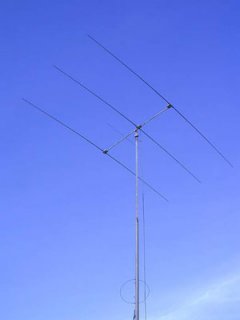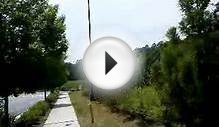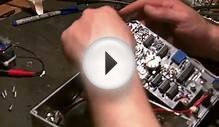
The simplest wire antenna for ham radio is a dipole, which is a piece of wire cut in the middle and attached to a feed line. The dipole gives much better performance than you may expect from such a simple antenna. To construct a dipole, use 10- to 18-gauge copper wire. It can be stranded or solid, bare or insulated.
While you’ll often see the formula for dipole length given as 468/f, the building process is a lot more reliable if you begin with a bit longer antenna and make one or two tuning adjustments. Start with an antenna length of
Length in feet = 490 / frequency of use in MHzAllow an extra 6 inches on each end for attaching to the end insulators and tuning and another 12 inches (6 inches × 2) for attaching to the center insulator. If you’re building a 10 meter dipole, you should start with a length of 490 / 28.3 = 17.3′ + 6″ + 6″ + 12″ = 19.3 feet.
To assemble the dipole, follow these steps:
- Cut the wire exactly in the middle, and attach one piece to each end insulator, just twisting it back on itself for the initial check.
- Attach the other end to the center insulator in the same way.
- Attach the feed line at the center insulator, and solder each connection.
- Attach some ropes, and hoist the antenna in the air.
- Check the dipole.
Make some short, low-power transmissions to measure the standing wave ratio (SWR, a measure of RF energy reflected back to the transmitter by the antenna), as explained in your radio’s operating manual, or use an antenna analyzer such as the MFJ-259B. The SWR should be somewhat less than 2:1 on the frequencies you want to use.
- Adjust the antenna’s length to SWR.
If the SWR is low enough but at too high a frequency or is lowest at the high end of the band, loosen the connections at the end insulators and lengthen the antenna by a few inches on each end.
If the frequency of lowest SWR is too low, shorten the antenna by the same amount.
- After you adjust the antenna length so that the SWR is satisfactory, make a secure wrap of the wire at the end insulators, solder the twist if you like, and trim the excess.
You’ve made a dipole!
You can follow the same steps for most simple wire antennas; just vary the lengths.
Most simple wire antennas cost only a few dollars and can be built and installed in an afternoon. There’s a special sense of satisfaction in making contacts via antennas that you built yourself.

You can connect the dipole directly to the transmitter with coaxial cable and use the dipole on the band at which it’s ¼ wavelength long or any odd number of ½ wavelengths. A dipole tuned for 7 MHz, for example, works reasonably well on the 21 MHz band, too, where it’s approximately 3 ½ wavelengths long.
Other common and simple wire antenna designs include
- Inverted-V: This dipole is supported at its midpoint, with the ends angling down at up to 45 degrees. This antenna requires only one tall, central support and gives good results in nearly all directions.
- Full-wavelength loop: Attach a feed line at the middle of the loop’s bottom and erect the loop so that it’s vertical. Then the feed line works best broadside to the plane of the loop. These antennas are larger than dipoles but radiate a little more signal in their favored directions.
- Multiple-band dipole: The wires of this antenna are fed at the center with open-wire or ladder-line feed line and used with an antenna tuner to cover several bands. These antennas usually aren’t ½ wavelength long on any band, so they’re called doublets to distinguish them from the ½-wavelength dipoles.
- Trap dipole: This antenna uses some appropriately placed components to isolate portions of the antenna at different frequencies so that the dipole acts like a simple ½ -wavelength dipole on two or more bands.
- Random-length wire: Attach some open-wire feed line 15 to 35 feet from one end, and extend the wire as far and high as you can. A couple of bends won’t hurt. You have to convert the feed line to coaxial cable using a balun or antenna tuner. This antenna’s performance is hard to predict, but it’s an excellent backup or temporary antenna.
For more information on these and many other antennas you can build, check out some of the references listed in Appendix B.
If you don’t have the perfect backyard to construct the antenna of your dreams, don’t be afraid to experiment. Get an antenna tuner (or use the one in your radio), and put up whatever you can. You can even bend wires or arrange them at strange angles. Antennas want to work!
INTERESTING VIDEO












